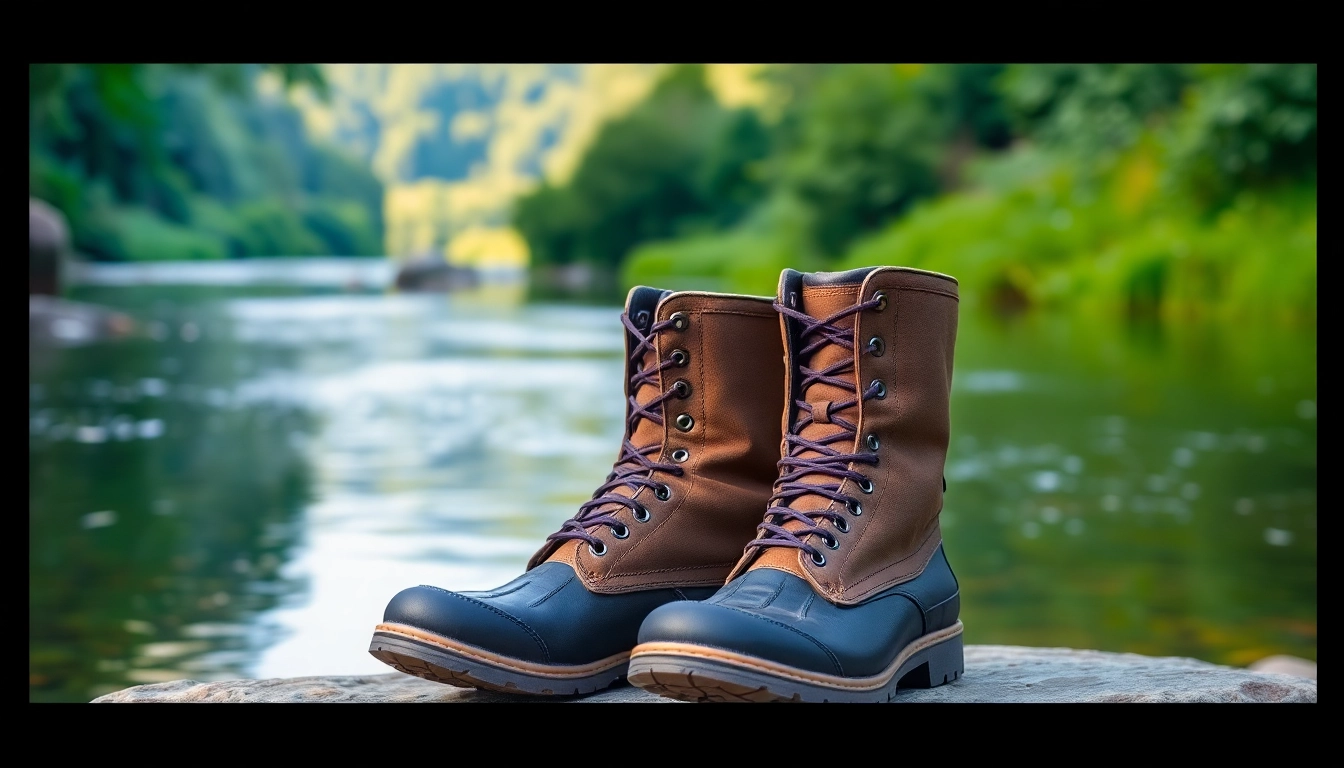Understanding the Importance of Fly Fishing Boots
When it comes to fly fishing, anglers know that the right gear can make all the difference in their experience on the water. One of the most critical pieces of equipment is often overlooked: Fly fishing boots. Choosing the right boots not only enhances comfort but also influences safety, performance, and overall enjoyment during fishing excursions. This article delves into the significance of fly fishing boots, highlights essential features, and provides guidance on making informed purchase decisions.
Why Proper Footwear Matters for Fly Fishing
Footwear plays a pivotal role in the safety and comfort of an angler. Fly fishing often involves wading through various terrains, including rocky riverbeds, slippery surfaces, and muddy banks. Proper footwear helps in maintaining balance and stability, reducing the risk of slips, falls, or injuries. Additionally, the right boots provide insulation, protecting feet from cold water and helping anglers stay comfortable throughout the day. In essence, investing in quality fly fishing boots ensures a more enjoyable and successful fishing experience.
Key Features to Look for in Fly Fishing Boots
When selecting fly fishing boots, certain features stand out as essential for performance and comfort:
- Traction: Look for boots with a sole designed for superior grip on wet surfaces. Studded rubber or felt soles are common choices for enhanced traction.
- Waterproofing: Opt for boots made from waterproof materials that keep feet dry, especially during long days of wading.
- Breathability: Breathable materials allow moisture to escape, reducing discomfort from sweat during warm weather.
- Support: Adequate ankle support is crucial for stability, especially on uneven terrain.
- Weight: Lightweight boots are preferable for ease of mobility, particularly when walking long distances.
Choosing Between Wading Boots and Fishing Shoes
Anglers often face the choice between wading boots and fishing shoes. Wading boots are specifically designed for fly fishing, with features that cater to the demands of wading in water. They typically have reinforced soles and higher tops for better ankle support. On the other hand, fishing shoes can be more casual, offering less protection but enhanced comfort for short fishing trips. Understanding the types of conditions you’ll be fishing in will help determine the best type of footwear to purchase.
Material Choices for Fly Fishing Boots
The materials used in the construction of fly fishing boots significantly influence their functionality, durability, and overall performance. Different materials offer various advantages, depending on the specific needs of the angler.
Breathable Fabrics: Enhancing Comfort and Performance
Breathable fabrics are crucial for fly fishing boots, especially in warm weather conditions. They promote airflow, keeping feet cool and reducing the risk of blisters. Common breathable materials include synthetic meshes and waterproof membranes that provide a balance between durability and breathability.
Diverse Sole Options: Rubber vs. Felt
The choice between rubber and felt soles is one of the most debated topics among anglers. Rubber soles offer excellent traction on rocky surfaces and are generally more durable, making them suitable for various terrains. Felt soles, while providing superior grip in slippery conditions, can wear out faster and are not recommended for areas with invasive species regulations. Understanding the environment in which you will fish is crucial to making the right choice.
The Role of Waterproofing in Fly Fishing Boots
Waterproofing is vital for fly fishing boots as wet feet can lead to discomfort and health issues such as frostbite during cold weather fishing. Look for boots that feature waterproof membranes and sealed seams to ensure complete protection from water ingress. It’s also beneficial to consider models that dry quickly, allowing anglers to transition seamlessly between wet and dry sections of their fishing trips.
Fit and Sizing Guidelines for Fly Fishing Boots
Achieving the correct fit is essential for both performance and comfort in fly fishing boots. Poorly fitting boots can result in blisters, decreased mobility, and an overall negative fishing experience.
How to Measure Your Feet for the Ideal Fit
To find the perfect fit for your fly fishing boots, start by measuring your feet accurately. Remove your socks and stand on a piece of paper, marking the longest part of your foot’s length and width. Repeat the process for both feet, as they may vary slightly in size. Consult the boot sizing chart of the manufacturer to determine which size corresponds with your measurements.
Adjustability Features to Consider
Adjustability is crucial for achieving a snug fit. Look for boots equipped with laces, adjustable straps, or BOA fit systems that allow you to customize the fit around your ankles and forefoot. This feature ensures that your boots remain secure while fishing, reducing the likelihood of discomfort or injury.
Trying Before You Buy: The Importance of Testing
Whenever possible, try on fly fishing boots before making a purchase. Walk around the store and mimic movements you’ll perform while fishing — like wading and climbing — to assess comfort and fit. Pay attention to pressure points and ensure you have adequate space to wiggle your toes. If you’re ordering online, consider retailers with generous return policies to try before fully committing.
Maintaining and Caring for Your Fly Fishing Boots
Proper maintenance and care can extend the life of your fly fishing boots and maintain their performance. A few simple practices are crucial for keeping your investment in top condition.
Cleaning Tips for Longevity
After each fishing trip, rinse your boots to remove mud, sand, and other debris. Use mild soap and a soft brush to clean stubborn dirt, especially in the sole and lacing areas. Allow them to air dry in a cool, shaded area, avoiding direct sunlight which can warp the materials. Regular cleaning helps prevent odors and prolongs the integrity of the boots.
Storage Best Practices to Prevent Damage
Proper storage is essential for fly fishing boots. Store them in a cool, dry place, away from moisture and direct sunlight. It’s helpful to stuff them with newspaper or specialized boot shapers to retain their shape and absorb any residual moisture. Avoid storing boots in tight spaces, which can cause creasing or damage over time.
When to Replace Your Fly Fishing Boots
Knowing when to replace your fly fishing boots is crucial for maintaining safety and performance. Signs that it may be time for a new pair include significant wear on the soles, noticeable leaks, or diminished support. Regularly inspecting your boots can save you from unexpected foot discomfort during your trips.
Comparing Popular Models of Fly Fishing Boots
With numerous options available, it can be overwhelming to choose the right fly fishing boots. Here’s a breakdown of considerations based on expected usage and budget.
Budget-Friendly Options for Beginners
For newcomers to fly fishing, budget-friendly boots can provide a great entry point without compromising on necessary features. Look for options that offer solid traction, comfortable fit, and reasonable waterproofing at a lower price point. Many respectable brands produce effective boots ranging from $80 to $150, making it easier for beginners to invest without breaking the bank.
High-End Models: Features and Benefits
High-end fly fishing boots typically come with advanced features such as lightweight materials, superior waterproofing, and specialized traction systems. These models can range anywhere from $200 to $500, providing top-tier comfort for serious anglers. Features such as interchangeable soles, reinforced toe boxes, and quick-drying technology make these purchases worthwhile for frequent fishers.
Consumer Reviews and Insights on Popular Choices
Consumer reviews can provide valuable insights into what your peers think about various models of fly fishing boots. Look for feedback on comfort, durability, fit, and real-world performance. Brands with consistent positive reviews often highlight their commitment to quality, which can guide you toward making an informed purchasing decision.
In conclusion, choosing the right fly fishing boots is an investment in comfort and safety on your angling adventures. By understanding the various features, materials, and options available, you can select boots that suit your needs and enhance your experience. Take the time to analyze your specific fishing conditions, try on various models, and engage in proper maintenance to ensure you make the most of your fly fishing outings.

